Page 105 of 258

Your Driving and the Road
that happens, release enough pressure on
the brakes to get the wheels rolling again
so that you can steer.
With the four-wheel drive option, you
won’t have anti-lock braking when you
shift into four-wheel drive. But
you will
have regular braking. When you shift
back into two-wheel drive, you will have
anti-lock again.
Braking in Emergencies
At some time, nearly every driver gets
into a situation that requires hard braking.
You have the rear-wheel anti-lock braking
system. Your front wheels can stop rolling
when you brake
very hard. Once they do,
the vehicle can’t respond to your steering.
Momentum
will carry it in whatever
direction it was headed when the front
wheels stopped rolling. That could be off
the road, into the very thing you were
trying to avoid, or into traffic.
So, use a “squeeze” braking technique.
This will give you maximum braking
while maintaining steering control.
You
do this by pushing on the brake pedal
with steadily increasing pressure. When
you do, it will help maintain steering
control. In many emergencies, steering
can help you more than even the
very best
braking.
. . .lo4
Steering
Power Steering
If you lose power steering assist because
the engine stops or the system is not
functioning, you can steer but
it will take
much more effort.
Steering Tips
Driving on Curves
It’s important to take curves at a
reasonable speed.
A lot of the “driver lost control” accidents
mentioned on the news happen on curves.
Here’s why:
Experienced driver or beginner, each of
us is subject to the same laws of physics
when driving on curves. The traction of
the tires against the road surface makes
it
possible for the vehicle to change its path
when you
turn the front wheels. If there’s
no traction, inertia will keep the vehicle
going
in the same direction. If you’ve
ever tried to steer a vehicle on wet ice,
you’ll understand this.
The traction you can get in a curve
depends on the condition of your tires and
the road surface, the angle at which
the
curve is banked, and your speed. While you’re
in a curve, speed
is the one factor
you can control.
Suppose you’re steering through a sharp
curve. Then
you suddenly apply the
brakes. Both control systems
- steering
and braking
- have to do their work
where the tires meet the road. Adding the
hard braking can demand too much at
those places.
You can lose control.
The same thing can happen if you’re
steering through a sharp curve and you
suddenly accelerate. Those two control
systems
- steering and acceleration -
can overwhelm those places where the
tires meet
the road and make you lose
control.
What should
you do if this ever happens?
Ease up on the brake or accelerator pedal,
steer the vehicle the way you want it to
go, and slow down.
Speed limit signs near curves warn that
you should adjust your speed. Of course,
the posted speeds are based on good
weather and road conditions. Under less
favorable conditions you’ll want to go
slower.
If you need to reduce your speed as you
approach a curve, do
it before you enter
ProCarManuals.com
Page 106 of 258

the curve, while your front wheels are
straight ahead.
Try to adjust your speed
so you can
“drive” through the curve. Maintain a
reasonable, steady speed. Wait to
accelerate until you are out of the curve,
and then accelerate gently into the
straightaway.
Steering in Emergencies
There are times when steering can be
more effective than braking. For example,
you come over a hill and find a truck
stopped in your lane, or a car suddenly
pulls out from nowhere, or a child darts
out from between parked cars and stops
right
in front of you. You can avoid these
problems by braking
- if you can stop in
time. But sometimes you can’t; there isn’t
room. That’s the time for evasive action
- steering around the problem.
Your Geo can perform very well in
emergencies like these. First apply your
brakes, but not enough
to lock your front
wheels. It is better to remove as much
speed as you can from a possible
collision. Then steer around the problem,
to the left or right depending on the space
available. 4n
emergency like this requires close
ittention and a quick decision.
If you are
holding the steering wheel at the
recommended
9 and 3 o’clock positions,
you can turn it a full
180 degrees very
quickly without removing either hand.
But you have to act fast, steer quickly,
and just as quickly straighten the wheel
once
you have avoided the object.
The fact that such emergency situations
are always possible is
a good reason to
practice defensive driving at all times and
wear safety belts properly.
Iff-Road Recovery
7ou may find sometime that your right
,heels have dropped off the edge of a
oad onto the shoulder
(A) while you’re
riving.
f the level of the shoulder is only slightl:
lelow the pavement, recovery should be
airly easy. Ease off the accelerator and
hen, if there is nothing in the way, steer
o that your vehicle straddles the edge of
he pavement. You can turn the steering
vheel up to
1/4 turn (B) until the right
ront tire contacts the pavement edge.
?hen turn your steering wheel to go
traight down the roadway.
105 ...
ProCarManuals.com
Page 107 of 258

Your Driving and the Road
Passing
The driver of a vehicle about to pass
another on a two-lane highway waits for
just
the right moment, accelerates, moves
around the vehicle ahead, then goes back
into the right lane again.
A simple
maneuver?
Not necessarily! Passing another vehicle
on a two-lane highway is
a potentially
dangerous move, since the passing
vehicle occupies the same lane as
oncoming traffic for several seconds.
A
miscalculation, an error in judgment, or a
brief surrender to frustration or anger can
suddenly put the passing driver face to
face with the worst of
all traffic accidents
- the head-on collision.
So here are some tips for passing:
“Drive ahead.’’ Look down the road,
to the sides, and to crossroads for
situations that might affect your
passing patterns. If you have any
doubt whatsoever about making a
successful pass, wait for a better time.
Watch for traffic signs, pavement
markings, and lines.
If you can see a
sign up ahead that might indicate
a
turn or an intersection, delay your
pass. A broken center line usually
0
0
indicates it’s all right to pass
(providing the road ahead is clear).
Never cross
a solid line on your side
of the lane or a double solid line, even
if the road seems empty of
approaching traffic.
Do not get too close to the vehicle you
want
to pass while you’re awaiting an
opportunity. For one thing, following
too closely reduces your area of
vision, especially
if you’re following a
larger vehicle.
Also, you won‘t have
adequate space if the vehicle ahead
suddenly slows or stops. Keep back a
reasonable distance.
When
it looks like a chance to pass is
coming up, start to accelerate but stay
in the right lane and don’t get too
close. Time your move so you will be
increasing speed
as the time comes to
move into the other lane. If the way is
clear
to pass, you will have a “running
start” that more than makes up for the
distance you would lose
by dropping
back. And if something happens to
cause you
to cancel your pass, you
need only slow down and drop back
again and wait for another
opportunity.
0
0
0
0
0
If other cars are lined up to pass a
slow vehicle, wait your turn.
But take
care that someone isn’t trying to pass
you as you pull out to pass the
slow
vehicle. Remember to glance over your
shoulder and check the blind spot.
Check your mirrors, glance over your
shoulder, and start your left lane
change signal before moving out
of
the right lane to pass. When you are
far enough ahead of the passed vehicle
to see its front
in your inside mirror,
activate your right lane change signal
and move back into the right lane.
(Remember that your right outside
mirror is convex. The vehicle you just
passed may seem
to be farther away
from you than
it really is.)
Try not to pass more than one vehicle
at a time on two-lane roads. Reconsider
before passing the next vehicle.
Don’t overtake a slowly moving
vehicle
too rapidly. Even though the
brake lights are not flashing,
it may
be slowing down or starting to
turn.
If you’re being passed, make it easy
for the following driver to get ahead
of you. Perhaps you can ease
a little
to the right.
. . .lo6
ProCarManuals.com
Page 108 of 258

loss of Control
Let's review what driving experts say
about
what happens when the three
control system (brakes, steering and
acceleration) don't have enough friction
where
the tires meet the road to do what
the driver has asked.
In any emergency. don't give up. Keep
trying
to steer and constantly seek an
escape route or area
of less danger.
Skidding
In a skid. a driver can lose control of the
vehicle. Defensive drivers avoid most
skids by taking reasonable care suited
to
existing conditions. and by not
"overdriving" those conditions. But skids
are always possible.
The three types
of skids correspond to
your Geo's three control systems. In the
braking skid your wheels are.n't rolling.
In
the steering or cornering skid, too much
speed or steering
in a curve causes tires to
slip and lose cornering force. And
in the
acceleration skid too much throttle causes
the driving wheels
to spin.
A cornering skid and an acceleration skid
are best handled by easing your foot off
the accelerator pedal.
If your vehicle starts to slide, ease your
foot 011' the accelerator pedal and quickly
steer the way
you want the vehicle to go.
If you start steering quickly enough. your
vehicle
may straighten out. 41ways be
ready for
;I sccond skid if it occurs.
Of course, traction is reduced when water,
snow. ice. gravel. or other material is on
the road. For safety, you'll want to slow
down and adjust your driving
to these
conditions.
It is important to slow down
on slippery surfaces because stopping
distance will be longer
and vehicle
control more limited.
While driving on
a surface with reduced
traction.
try your best to avoid sudden
steering, acceleration,
or braking
(including engine braking by shifting
EO a
lower gear).
Any sudden changes could
cause the tires to slide. You may
not
realize the surface is slippery until yout-
vehicle is skidding. Learn
to recognize
warning clues
~ such as enough water,
ice or packed snow
on the road to make ;1
"nlir~-or.ed surf'rlce" - and slow down
when you have any doubt.
Remember: The rex-wheel anti-lock
braking system (RWAL) helps avoid
only
a rear braking skid. In a braking skid
(where the front wheels are
no longer rolling),
release enough pressure
on the
brakes to get the front wheels rolling
again. This restores steering control. Push
the brake pedal down steadily when you
have
to stop suddenly. As long as the
I'ront wheels are rolling,
you will have
sleering control.
Driving Guidelines
This multipurpose passenger vehicle is
defined as a utility vehicle in Consumer
Information Regulations issued
by the
National I-lighway Traffic Safety
Administration (NHTSA)
of the United
States Department of Transportation.
Utility vehicles have higher ground
clearance and a narrower track to make
them capable of performing
in a wide
variety
of off-road applications. Specific
design characteristics give them a higher
center of gravity than ordinary cars. An
advantage
of the higher ground clearance
is
a better view of the road allowing you
to anticipate problems. They are not
designed for cornering
at the same speeds
as conventional 2-wheel drive vehicles
any no re than low-slunl 7 .'p '-, orts cars are
designed
to perform satisfitctorily under
off-road conditions.
If at all possible,
avoid shurp turns or abrupt maneuvers.
107 ...
ProCarManuals.com
Page 109 of 258

Your Driving and the Road
As with other vehicles of this type, failure
to operate this vehicle correctly may
result
in loss of control or vehicle
rollover.
Off-Road Driving with
Your Geo Four-wheel
Drive Vehicle
This off-road guide is for vehicles that
have four-wheel drive.
Also, see “Anti-lock Brakes”
in the Index.
If your vehicle doesn’t have four-wheel
drive, you shouldn’t drive off-road unless
you’re
on a level, solid surface.
Off-road driving can be great fun. But
it
does have some definite hazards. The
greatest of these is the terrain itself.
“Off-roading” means
you’ve left the great
North American road system behind.
Traffic lanes aren‘t marked. Curves aren’t
banked. There are no road signs. Surfwes
can be slippery, rough, uphill
or downhill.
In short, you’ve gone right back to nature.
Off-road driving involves
some new
skills. And that’s
why it’s very important
that
you read this guide. You’ll find many
driving tips and suggestions. These
will
help make your off-road driving safer and
more enjoyable.
=. .lo8
Before You Go Off-Roading
There are some things to do before you
go out. For example, be sure to have all
necessary maintenance and service work
done. Be sure you read all the information
about your four-wheel drive vehicle in
this manual. Is there enough fuel? Is the
spare tire
fully inflated‘? Are the fluid
levels up where they should
be‘? What are
the local laws
that apply to off-roacting
where you’ll be driving?
If you don’t
know, you should check with law
enforcement people
in the area. Will you
be on someone’s private land?
If so, be
sure
to get the necessary permission.
Loading Your Vehicle for Off-Road
Driving
There are some important things to
remember
about how to load your
vehicle. The heavies1 things should
be on the
load floor and forward of your rear
axle. Put heavier items
as far forward
as you can.
e Be sure the load is secured properly,
so driving on the off-road terrain
doesn’t
toss things around.
You’ll find other important information in
this manual. See “Vehicle Loading” and
”Tires”
in the Index.
ProCarManuals.com
Page 110 of 258

Traveling to Remote Areas
It makes sense to plan your trip,
especially when going to a remote area.
Know the terrain and plan your route. You
are much less likely to get bad surprises.
Get accurate maps of trails and terrain.
Try to learn of any blocked or closed
roads.
It’s also a good idea to travel with at least
one other vehicle.
If something happens
to one of them, the other can help quickly.
Does your vehicle have a winch? If
so, be
sure to read the winch instructions. In a
remote area, a winch can be handy if you
get stuck. But you’ll want to know how to
use it properly.
Getting Familiar with Off-Road
Driving
It’s a good idea to practice in an area
that’s safe and close to home before you
go into the wilderness. Off-road driving
does require some new and different
driving skills. Here’s what we mean.
Tune your senses to different kinds of
signals. Your eyes, for example, need to
constantly sweep the terrain for
unexpected obstacles. Your ears need to
listen for unusual tire or engine sounds. With
your arms, hands, feet, and body
you’ll need to respond to vibrations and
vehicle bounce.
Controlling your vehicle is the key to
successful off-road driving. One
of the
best ways to control your vehicle is to
control your speed. Here are some things
to keep in mind. At higher speeds:
0 you approach things faster and you
have less time to scan the terrain for
obstacles.
0 you have less time to react.
0 you have more vehicle bounce when
you drive over obstacles.
0 you’ll need more distance for braking,
especially since you’re on an unpaved
surface.
Scanning the Terrain
Off-road driving can take you over many
different kinds of terrain. You need to be
familiar with the terrain and its many
different features. Here are some things to
consider.
Surface Conditions. Off-roading can
take you over hard-packed dirt, gravel,
rocks, grass, sand, mud, snow or ice.
Each of these surfaces affects the steering,
acceleration, and braking of your vehicle
in different ways. Depending upon the
kind of surface you are on, you may
experience slipping, sliding, wheel
spinning, delayed acceleration, poor
traction, and longer braking distances.
Surface Obstacles. Unseen or hidden
obstacles can be hazardous.
A rock, log,
hole, rut, or bump can startle you if
you’re not prepared for them. Often these
obstacles are hidden by grass, bushes,
snow or even the rise and fall
of the
terrain itself. Here are some things to
consider:
0 Is the path ahead clear?
0 Will the surface texture change
abruptly up ahead?
109 ...
ProCarManuals.com
Page 111 of 258

Your Driving and the Road
0 Does the travel take you uphill or
downhill? (There’s more discussion of
these subjects later.)
change direction quickly?
0 Will you have to stop suddenly or
When you drive over obstacles or rough
terrain, keep a firm grip
on the steering
wheel.
Ruts, troughs, or other surface
features can jerk the wheel out of your
hands
if you’re not prepared.
When you drive over bumps, rocks, or
other obstacles, your wheels can leave
the
ground. If this happens, even with one or
two wheels, you can’t control the vehicle
as well or at all.
Because you will be on an unpaved
surface,
it’s especially important to avoid
sudden acceleration, sudden turns, or
sudden braking.
In a way, off-road driving requires a
different kind of alertness from driving on
paved roads and highways. There are no
road signs, posted speed limits or signal
lights.
You have to use your own good
judgment about what is safe and what
isn’t.
Drinking and driving can be very
dangerous on any road. And this
is
certainly true for off-road driving. At the
. . .I10
very time you need special alertness and
driving skills, your reflexes, perceptions
and judgment can be affected by even a
small amount of alcohol.
You could have
a serious - or even fatal - accident if
you drink and drive or ride with a driver
who has been drinking. (See “Drunken
Driving”
in the Index.)
Driving On Off-Road Hills
Off-road driving often takes you up,
jown, or across a hill. Driving safely on
hills requires good judgment and an
understanding of what your vehicle can
md can’t do. There are some hills that
;imply can’t be driven, no matter how
well built the vehicle.
Approaching a Hill
When you approach a hill, you need to
decide if
it’s one of those hills that’s just
too steep to climb, descend, or cross.
Steepness can be hard
to judge. On a very
small
hill, for example, there may be a
smooth, constant incline with only a small
change
in elevation where you can easily
see all the way to the top. On a large hill,
the incline may get steeper as you near
the top, but you may not see this because
the crest of
the hill is hidden by bushes,
grass,
or shrubs.
Here are some other things
to consider as
you approach a hill.
Is there a constant incline, or does the
hill get sharply steeper in places?
Is there good traction on the hillside,
or will the surface cause tire slipping?
Is there a straight path up or down the
hill so you won’t have to make turning
maneuvers?
Are there obstructions on the hill that
can block your path (boulders, trees,
logs or ruts)?
What’s beyond the hill?
Is there a cliff,
an embankment, a drop-off, a fence?
Get out and walk the
hill if you don’t
know. It’s the smart way to find out.
ProCarManuals.com
Page 112 of 258

0 Is the hill simply too rough‘? Steep hills
often have ruts, gullies, troughs and
exposed rocks because
they are more
susceptible
to the effects of erosion.
Driving Uphill
Once you decide you can safely drive up
the hill,
you need to take some special
steps.
0 Use a low gear and get a firm grip on
the steering wheel.
Get a smooth start up the hill and try
to maintain your speed. Don’t use
more power than
you need, because
you don’t want your wheels
to start
spinning or sliding.
Try to drive straight up the hill if at a1
possible.
If the path twists and turns,
you might want to find another route.
0
0
0
0
Ease up on your speed as you
approach the top
of the hill.
Attach a flag to the vehicle to tnake
you more visible to approaching
traffic on trails
or hills.
Sound the
horn as you approach the
top
of the hill to let opposing traffic
know you’re there.
Use your headlights even during the
day. They make you more visible
to
oncoming traffic.
Q: What should I do if my vehicle
A:
0
0
0
0
stalls, or is about to stall, and I can’t
make
it up the hill?
If this happens, there are some things
you should do, and there are some
things you must not do. First, here’s
what you should do:
Push the brake pedal
to stop the
vehicle and keep
it from rolling
backwards. Also, apply
the parking
brake.
If your engine is still running, shift the
transmission into reverse, release the
parking brake, and slowly back down
the
hill in reverse.
If your engine has stopped running,
you’ll need to restart it. With the brake
pedal depressed and
the parking brake
still applied,
shift the transmission to
“P” (Park) (or, shift to “N” (Neutral)
if your vehicle has a manual
transmission) and restart
the engine.
Then, shift
to reverse, release the
parking brake, and slowly back down
the
hill as straight as possible in
reverse.
As you are backing down the hill, put
your left hand
on the steering wheel at
the
12 o’clock position. This way,
111 . . .
ProCarManuals.com
 1
1 2
2 3
3 4
4 5
5 6
6 7
7 8
8 9
9 10
10 11
11 12
12 13
13 14
14 15
15 16
16 17
17 18
18 19
19 20
20 21
21 22
22 23
23 24
24 25
25 26
26 27
27 28
28 29
29 30
30 31
31 32
32 33
33 34
34 35
35 36
36 37
37 38
38 39
39 40
40 41
41 42
42 43
43 44
44 45
45 46
46 47
47 48
48 49
49 50
50 51
51 52
52 53
53 54
54 55
55 56
56 57
57 58
58 59
59 60
60 61
61 62
62 63
63 64
64 65
65 66
66 67
67 68
68 69
69 70
70 71
71 72
72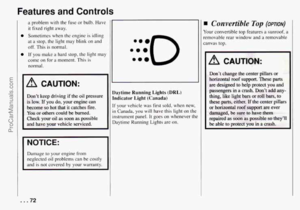 73
73 74
74 75
75 76
76 77
77 78
78 79
79 80
80 81
81 82
82 83
83 84
84 85
85 86
86 87
87 88
88 89
89 90
90 91
91 92
92 93
93 94
94 95
95 96
96 97
97 98
98 99
99 100
100 101
101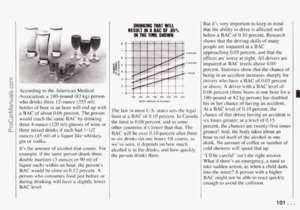 102
102 103
103 104
104 105
105 106
106 107
107 108
108 109
109 110
110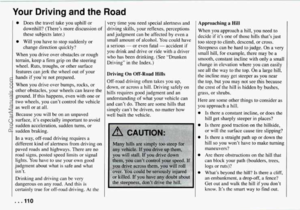 111
111 112
112 113
113 114
114 115
115 116
116 117
117 118
118 119
119 120
120 121
121 122
122 123
123 124
124 125
125 126
126 127
127 128
128 129
129 130
130 131
131 132
132 133
133 134
134 135
135 136
136 137
137 138
138 139
139 140
140 141
141 142
142 143
143 144
144 145
145 146
146 147
147 148
148 149
149 150
150 151
151 152
152 153
153 154
154 155
155 156
156 157
157 158
158 159
159 160
160 161
161 162
162 163
163 164
164 165
165 166
166 167
167 168
168 169
169 170
170 171
171 172
172 173
173 174
174 175
175 176
176 177
177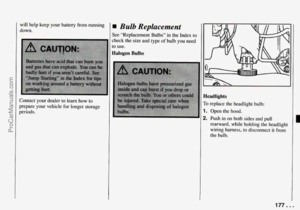 178
178 179
179 180
180 181
181 182
182 183
183 184
184 185
185 186
186 187
187 188
188 189
189 190
190 191
191 192
192 193
193 194
194 195
195 196
196 197
197 198
198 199
199 200
200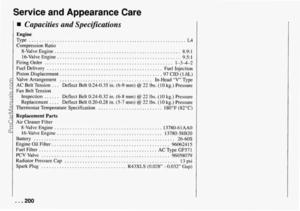 201
201 202
202 203
203 204
204 205
205 206
206 207
207 208
208 209
209 210
210 211
211 212
212 213
213 214
214 215
215 216
216 217
217 218
218 219
219 220
220 221
221 222
222 223
223 224
224 225
225 226
226 227
227 228
228 229
229 230
230 231
231 232
232 233
233 234
234 235
235 236
236 237
237 238
238 239
239 240
240 241
241 242
242 243
243 244
244 245
245 246
246 247
247 248
248 249
249 250
250 251
251 252
252 253
253 254
254 255
255 256
256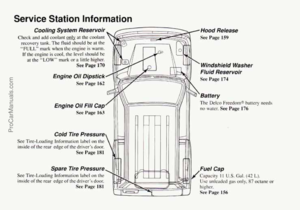 257
257






